- Yokohama-shi Top Page
- Living and Procedures
- Community Development and Environment
- Environmental Conservation
- Survey and observation
- Institute for Environmental Science
- Environmental measurement data
- Results of surveys of hazardous air pollutants
Here's the text.
Results of surveys of hazardous air pollutants
Last Updated April 7, 2021
The Institute for Environmental Science conducts surveys of hazardous air pollutants in the environment.
On this page, we will inform you of the survey results.
For an overview of the survey, see the survey page on air and water environment.
Hazardous air pollutants measured by the Institute for Environmental Science
The 15 harmful air pollutants measured by the Institute of Environmental Science are as follows.
Benzen, trichloroethylene, tetrachloroethylene, dichloromethane, acrylonitrile, acetaldehyde, vinyl chloride monomer, methyl chloride, chloroform, 1,2-dichloroethane, 1,3-butadiene, formaldehyde, benzol (a), pyrene, dioxin, dioxin, dioxin, dichloride, dichloroethylene, dichloroethylene, 1, 1, 1, dichloroethylene, 1, 1, 1, formalde, 1, formalde, 1, 1, 1, 1, chlorodehydehydehyde, 1, chloroethylene, 1, 1
For dioxins, please refer to the Environmental Environmental Pollution Monitoring Center page.
Survey points
There are five survey points in Yokohama City.
Shiota conducts surveys every year, and in Miho and Takigashira, surveys are conducted in even-numbered years, and in Honmoku and Yazawa, odd years.
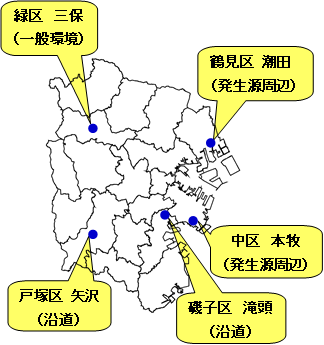
(Reference) About regional classification
- "General environment" is a point where it is considered not directly affected by the emission of harmful air pollutants from fixed sources or mobile sources.
- "Around fixed sources" is a point where the concentration of substances that are expected to emit harmful air pollutants at fixed sources is considered to be relatively high compared to other locations on fixed sources.
- "Roadside" is a point where the concentration of harmful air pollutants expected to be emitted from automobiles is considered to be relatively high compared to other places along the road.
Results of the survey
The survey results are shown for 14 of the 15 substances measured by our laboratory, excluding dioxins, according to the prescribed standards.
Results of surveys of four substances subject to environmental standards
Benzene, trichloroethylene, tetrachloroethylene, dichloromethane
Of the 14 substances measured by our laboratory, the survey results of four substances with environmental standards (benzene, trichloroethylene, tetrachloroethylene, dichloromethane) are shown.
Environmental standards are standards set based on the Basic Environmental Law and are desirable to be maintained to protect human health and preserve the living environment.
| Substances | Environmental Conditions |
|---|---|
| Benzene | The annual average value is 0.003 mg / m3 (3 μg / m3) or less. |
| Trichloroethylene | The annual average value is 0.13 mg / m3 (130 μg / m3) or less. |
| Tetrachloroethylene | The annual average value is 0.2 mg / m3 (200 μg / m3) or less. |
| Dichloromethane | The annual average value is 0.15 mg / m3 (150 μg / m3) or less. |
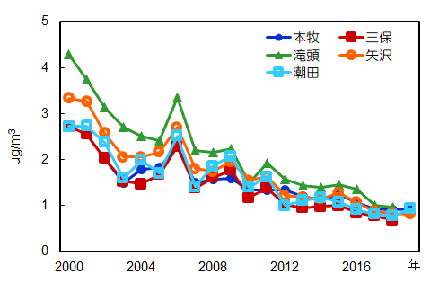 Benzene (environmental standard: 3μg/m3)
Benzene (environmental standard: 3μg/m3)
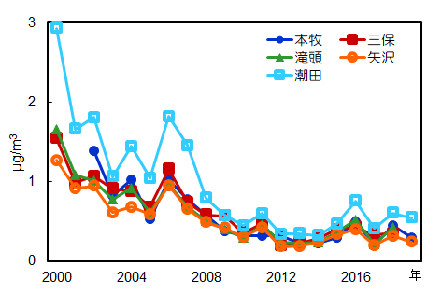 Trichloroethylene (environmental standard: 130 μg/m3)
Trichloroethylene (environmental standard: 130 μg/m3)
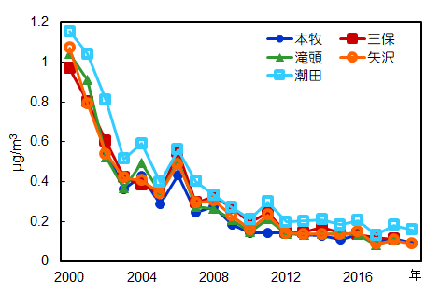 Tetrachloroethylene (environmental standard: 200 μg/m3)
Tetrachloroethylene (environmental standard: 200 μg/m3)
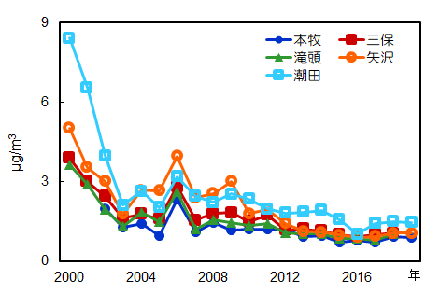 Dichloromethane (environmental standard: 150 μg/m3)
Dichloromethane (environmental standard: 150 μg/m3)
At the beginning of monitoring in 2000, there were some points that exceeded the environmental standard values, but all of them were on a downward trend, and since fiscal 2003, almost no longer exceeded the environmental standards.
For trichloroethylene, tetrachloroethylene, and dichloromethane, no point exceeding the environmental standard was observed since the beginning of monitoring.
Survey results of 7 substances with guideline values
Acrylonitrile, acetaldehyde, vinyl chloride monomer, methyl chloride, chloroform, 1,2-dichloroethane, 1,3-butadiene
Of the 14 substances measured by our institute, 7 substances with reference values (acrylonitrile, acetaldehyde, vinyl chloride monomer, methyl chloride, chloroform, 1,2-dichloroethane, 1,3-butadiene) are shown.
Guideline values are numerical values that serve as guidelines for reducing health risks caused by harmful air pollutants in the environment.
| Substances | Environmental Conditions |
|---|---|
| Acrylonitrile | The annual average value is 2 μg/m3 or less. |
| Acetaldehyde | The annual average value is 120 μg/m3 or less. |
| Vinyl chloride monomer | The annual average value is 10 μg/m3 or less. |
| Methyl chloride | The annual average value is 94 μg/m3 or less. |
| Chloroform | The annual average value is 18 μg/m3 or less. |
| 1,2-dichloroethane | The annual average value is 1.6 μg/m3 or less. |
| 1,3-butadiene | The annual average value is 2.5 μg/m3 or less. |
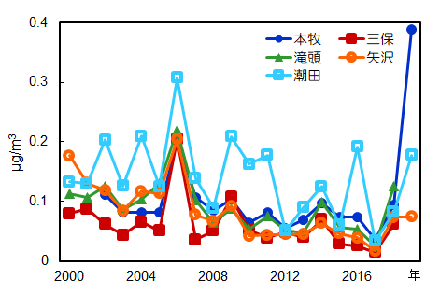 Acrylonitrile (guided value: 2 μg/m3)
Acrylonitrile (guided value: 2 μg/m3)
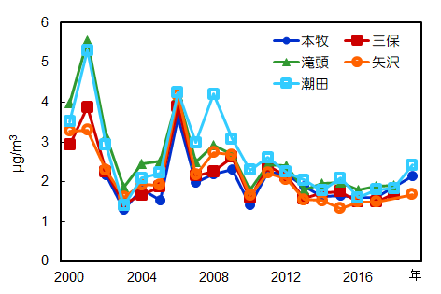 Acetaldehyde (guided value: 120 μg/m3)
Acetaldehyde (guided value: 120 μg/m3)
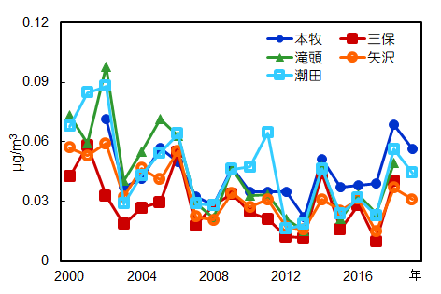 Vinyl chloride monomer (guided value: 10 μg/m3)
Vinyl chloride monomer (guided value: 10 μg/m3)
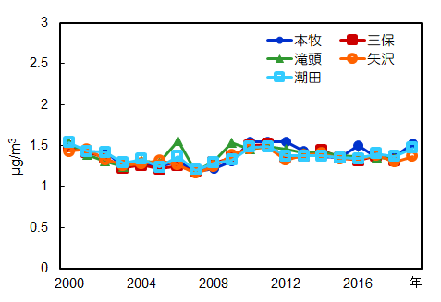 Methyl chloride (guided value: 94 μg/m3)
Methyl chloride (guided value: 94 μg/m3)
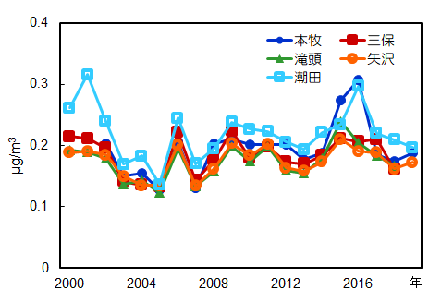 Chloroform (guided value: 18 μg/m3)
Chloroform (guided value: 18 μg/m3)
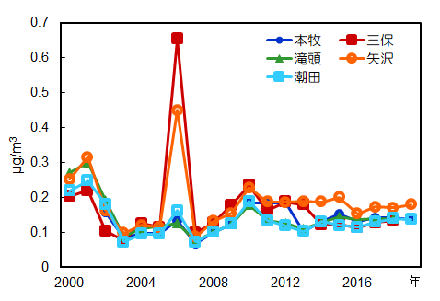 1,2-dichloroethane (guided value: 1.6 μg/m3)
1,2-dichloroethane (guided value: 1.6 μg/m3)
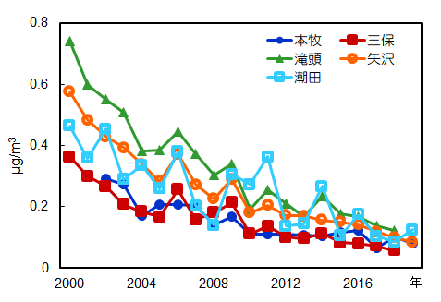
1,3-butadiene (guide value: 2.5 μg/m3)
For acrylonitrile, acetaldehyde, vinyl chloride monomer, methyl chloride, chloroform, 1,2-dichloroethane, and 1,3-butadiene, no point exceeded the guideline values from the beginning of monitoring.
Results of Survey of Three Other Substances
Formaldehyde, benzo(a) pyrene, toluene
Of the 14 substances measured by our laboratory, 3 substances that do not have environmental standards or guideline values are shown.
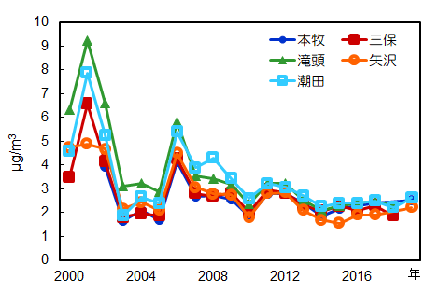 Formaldehyde
Formaldehyde
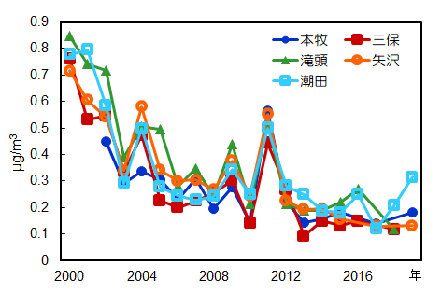 Benzo (a) pyrene
Benzo (a) pyrene
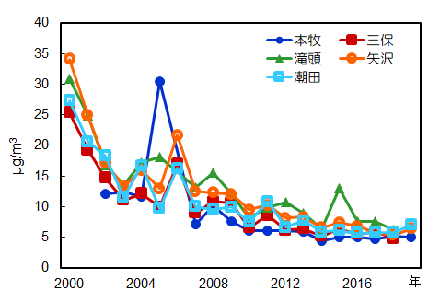
Toluene
Inquiries to this page
Environmental Science Research Institute, Environmental Conservation Department, Green Environment Bureau
Telephone: 045-453-2550
Telephone: 045-453-2550
Fax: 045-453-2560
Email address: mk-kanken@city.yokohama.lg.jp
Page ID: 934-879-312







